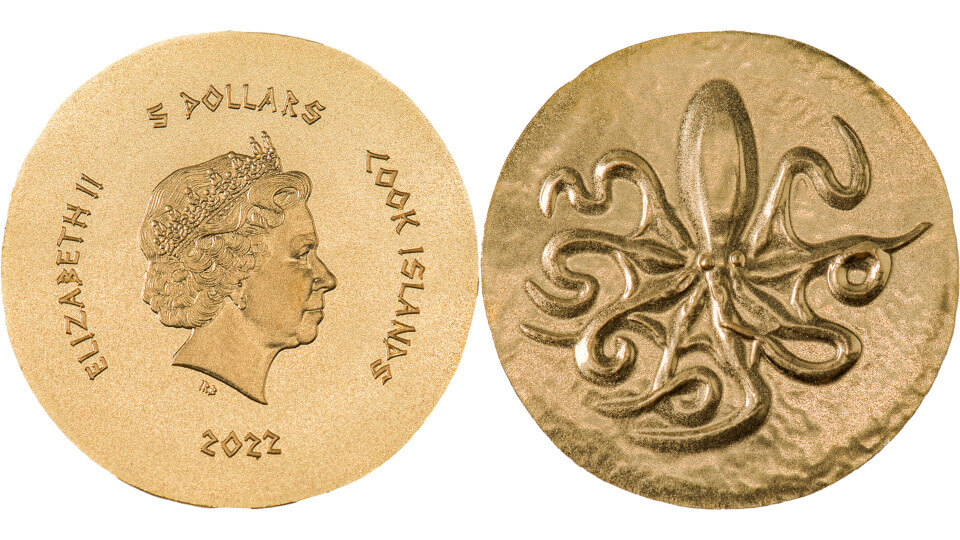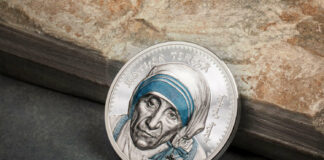
After the great success of the first “Ancient Greece” coin series, in 2022 CIT presents the second issue of the series. In 2020, the first and award-winning coin of the successful series Numismatic Icons was issued. With Tortoise, Athena’s Owl and Pegasos, CIT brought the most popular Greek coin types into contemporary numismatics. In 2022, CIT decided to also start a series of small gold coins featuring the same motifs – which was a major success. Now, CIT will complement the Numismatic Icons with the “Ancient Greece” series. The designers selected some of the most beautiful animal motifs from ancient times as well as the best-known coin types of Hellenism. The coins were minted in the B. H. Mayer’s Kunstprägeanstalt in Munich.
Description
The obverse of all issues features the portrait of Queen Elizabeth II by Ian Rank-Broadley (initials: IRB); around it the name of the ruler, the issuing nation and the denomination.
Reverses
- Crab – Akragas
On a rough surface, the reverse features a crab common to most coins of the Sicilian city of Akragas.
- Dolphins and Tuna – Cyzicus
On a rough surface, the reverse depicts two dolphins swimming to the left, between them a tuna fish modelled after an electrum stater type of Cyzicus.
- Octopus – Syracuse
On a rough surface, the reverse shows an octopus as can be found on many fractions of the Sicilian city of Syracuse.
- Philip II of Macedon
The design of the reverse is inspired by the gold staters of the Philip type. On a rough surface, they show the head of Apollo with laurel wreath facing right.
- Alexander the Great
The design of the reverse is inspired by the gold staters of the Alexander type. On a rough surface, they show the head of the goddess Athena with a Corinthian helmet facing right.
- Ptolemaios I
The design of the reverse is inspired by the gold staters of Ptolemaios I featuring his portrait. He wears the diadem of the king and the aegis around his neck.
Background
The Crab of Akragas, the Tuna of Cyzicus and the Octopus of Syracuse – all three motifs bear testimony to the impressive precision with which Greek artists observed their environment. The skill with which they transformed the fauna of their immediate surroundings into realistic and yet slightly stylized animal motifs is unparalleled to this day.
In a second block, CIT picks up the depictions of three central gold coins of Greek monetary history. The first issue features Apollo, as Philip of Macedonia chose him to be depicted on his gold staters. After a long phase during which silver was the dominant minting material, Philip was the first one to opt for gold coins again. His son Alexander, who is readily dubbed “the Great”, succeeded him. Alexander spread the gold stater that his father had created featuring a new image – the goddess Athena – throughout all the territories he conquered. After his death, Alexander’s empire disintegrated into many dominions, which, however, built on what they had adopted from his rule. An example for this is Ptolemaios, the Macedonian general who became the ruler of Egypt and not only put his own portrait on coins but also introduced Greek money in Egypt, which had still been a traditional economy prior to his rule.
It is remarkable how CIT succeeds in capturing the beauty of the ancient models on gold coins that weight as little as 0.5 g with a diameter of 11mm. Thanks to state-of-the-art minting technology, B.H. Mayer downright revolutionized the appearance of the small gold coins.
For more information on the coins, visit CIT’s website.
In the online database of Cosmos of Collectibles, you can find many more CIT coins!
Don’t miss any new coin issues! Subscribe to the Cosmos of Collectibles newsletter for free.
Here we presented CIT’s Pegasos coin.
If you are interested in ancient coins, don’t miss our archive sections Greece (Antiquity) and Greek coins.







